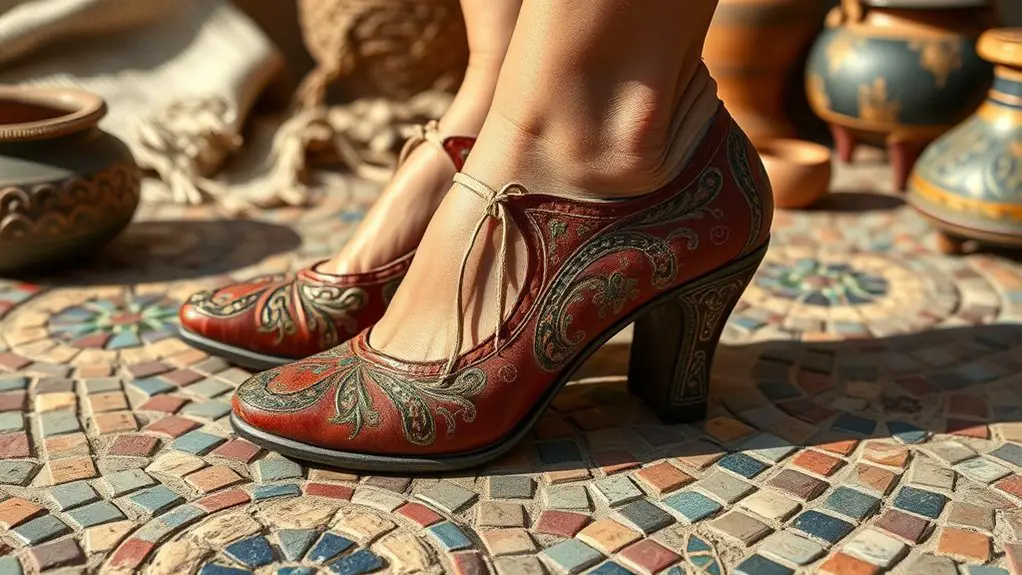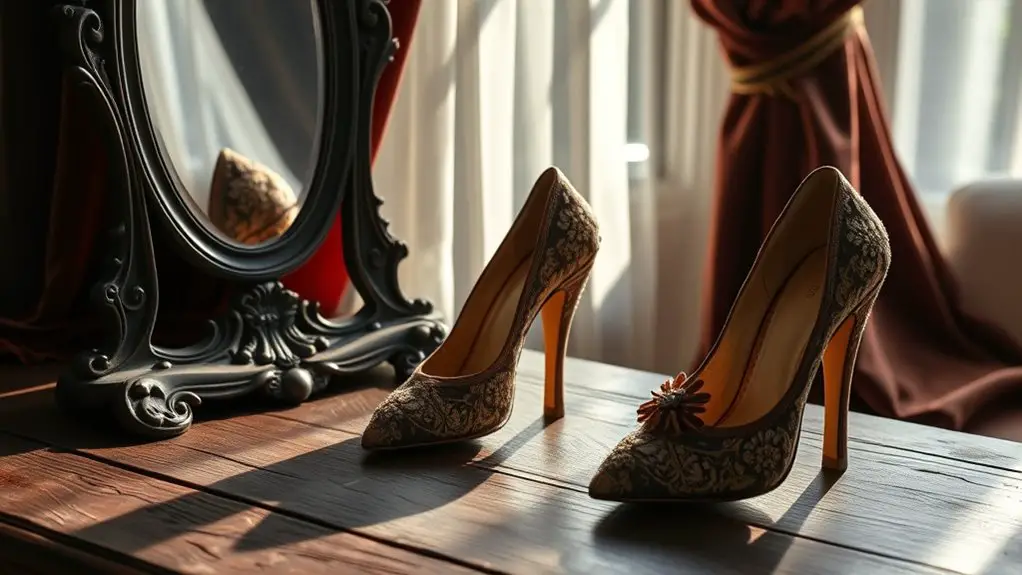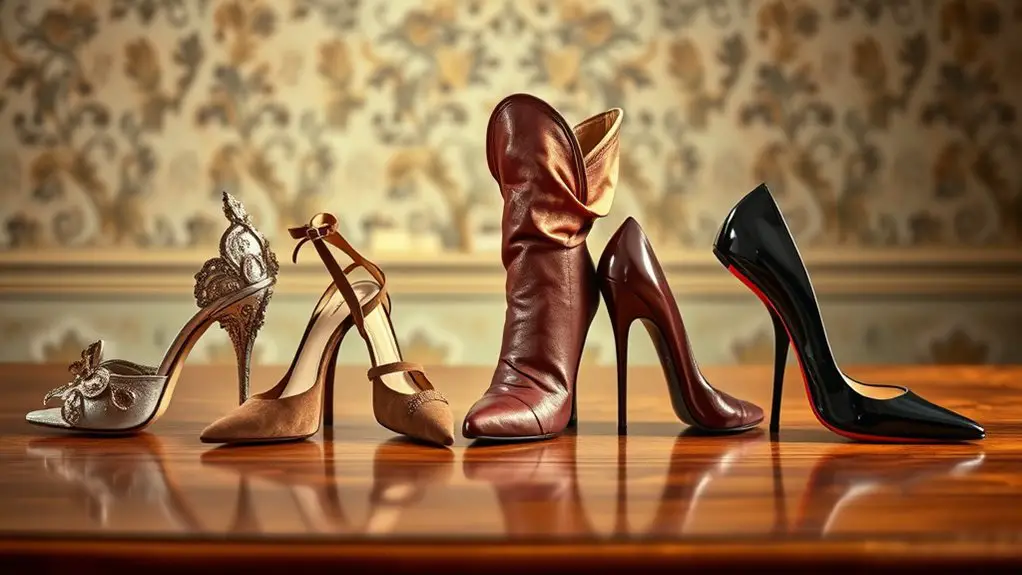High heels have transformed dramatically since their inception in the 10th century, initially serving practical purposes for horseback riders. By the Renaissance, they became status symbols for the nobility, enhancing stature and social standing. Women embraced high heels in the 17th century, marking their evolution into expressions of individuality. Although they waned in popularity during the 19th century due to societal shifts, high heels have since regained significance as symbols of empowerment and innovation. Discover how this fascinating journey unfolds further.
The Origins of High Heels: Practicality in the 10th Century

While many associate high heels with modern fashion, their origins can be traced back to the 10th century, where practicality played a pivotal role. During this era, medieval footwear was not just about aesthetics; it was a functional response to the demands of daily life. High-heeled shoes were initially designed for horseback riding, allowing riders to secure their feet in stirrups more effectively. The Persian influences on these designs introduced elevated heels, which provided stability and support.
As these styles spread across Europe, they evolved from pure utility to a blend of functionality and fashion. The elevated soles helped protect the wearer from mud and debris, a common concern in medieval times. This practical innovation laid the groundwork for the later embellishment of high heels, transforming them into symbols of status and identity. By understanding these origins, you can appreciate the complex journey of high heels throughout history.
High Heels in the Renaissance: A Sign of Status
During the Renaissance, high heels became more than just footwear; they transformed into a bold fashion statement for the nobility. You’d notice that these elevated shoes not only enhanced stature but also reflected one’s social standing in court life. This era showcased how practicality and status intertwined, emphasizing the importance of appearance in a world driven by hierarchy and influence.
Fashion Statement of Nobility
As the Renaissance flourished in Europe, high heels emerged as a potent symbol of nobility and social status, reflecting the era’s obsession with elegance and opulence. You’d notice that nobility fashion during this period was all about showcasing wealth and refinement. High heels, often adorned with intricate designs, accentuated the wearer’s height, making them appear more imposing and regal. This high heel symbolism transcended mere footwear; it became a declaration of one’s place within the rigid class structure. Nobles wore these stylish shoes not just for aesthetics but to convey authority and superiority. As you observe this transformation, it’s clear that high heels were more than just a trend; they were an essential part of the identity of the upper class.
Practicality in Court Life
High heels not only served as a fashion statement for the nobility but also played a practical role in court life during the Renaissance. Within the confines of royal courts, adherence to court etiquette was paramount, and your footwear needed to reflect this decorum. High heels, by elevating your stature, showcased your social rank and helped you command attention in gatherings. Additionally, they provided a functional advantage; while impractical by today’s standards, they offered stability on polished floors, allowing you to navigate court settings gracefully. In this situation, high heels weren’t just a stylish choice; they were practical footwear that reinforced your status while ensuring you maintained poise among the elite. Consequently, they embodied both form and function during this opulent era.
The Rise of Women’s High Heels in the 17th Century

While societal norms in the 17th century were rapidly evolving, women’s fashion took a bold turn with the adoption of high heels, which served not only as a statement of style but also as a symbol of status. This period marked a significant fashion evolution, where high heels became an integral part of women’s attire, reflecting changing gender roles. By elevating women physically, these shoes also elevated their societal position, allowing them to assert themselves in a male-dominated world.
As you walked through opulent ballrooms, high heels distinguished affluent women from their lower-class counterparts. The elaborate designs and vibrant colors showcased wealth and taste, while the added height accentuated the skirts of voluminous gowns, creating an elegant silhouette. This shift in footwear signaled a new era, where women began to embrace fashion as a powerful tool for self-expression and social mobility, challenging traditional norms and expectations.
Men in High Heels: A Fashion Statement in the 18th Century
In the 18th century, high heels transformed into a striking emblem of aristocratic status for men, signaling wealth and social standing. Notably, these elevated shoes also offered practicality in warfare, providing stability and a commanding presence on the battlefield. This dual purpose not only shaped men’s fashion but also reflected the complex interplay between status and functionality in that era.
Aristocratic Symbol of Status
As society evolved in the 18th century, men began to adopt high heels not merely as footwear but as a bold statement of aristocratic status. High heels became an essential element of aristocratic fashion, symbolizing power and wealth. The elevated heel allowed men to enhance their stature, emphasizing their position within the rigid social hierarchy of the time. These shoes were often made from luxurious materials, adorned with intricate designs, making them a visual representation of one’s social standing. By wearing high heels, men communicated their elite status, aligning themselves with the cultural norms of aristocracy. This fashion choice wasn’t just about aesthetics; it was a deliberate act of social signaling, reinforcing the distinctions that defined their world.
Practicality in Warfare
High heels, initially embraced by men as a symbol of aristocratic status, also found their way into the complexities of warfare during the 18th century. While modern military footwear prioritizes practicality, high heels served a unique historical functionality on the battlefield. They elevated soldiers, both literally and figuratively, providing advantages in stature and visibility. You might find it surprising that:
- High heels reinforced the image of authority among officers.
- They improved balance on uneven terrain.
- The elevation aided in mounting horses more easily.
- Decorative designs could intimidate enemies.
In this context, high heels transcended mere fashion, becoming a strategic element in warfare. This blend of style and functionality exemplifies the fascinating evolution of high heels beyond their original purpose.
The Decline of High Heels: Social Changes in the 19th Century

While the 19th century saw many societal shifts, the decline of high heels reflected deeper changes in fashion and gender roles. As the industrial revolution transformed daily life, practicality became more valued in women’s clothing. High heels, once symbols of status and femininity, increasingly felt restrictive and impractical. With the rise of feminist movements advocating for women’s rights and equality, the emphasis on comfort and functionality gained traction.
Women began to reject the notion that beauty required suffering, instead opting for flatter, more sensible footwear. This shift was not merely a fashion statement; it symbolized a broader desire for independence and agency. The evolving social landscape demanded new expressions of identity, and high heels, once a hallmark of femininity, lost their allure in favor of styles promoting mobility and autonomy. Consequently, the decline of high heels marked a significant turning point in women’s fashion and societal expectations.
The 20th Century Resurgence: High Heels as Feminine Empowerment
With the advent of the 20th century, high heels underwent a remarkable transformation, evolving from symbols of oppression into powerful tools of feminine empowerment. This shift coincided with significant cultural changes, as women began to assert their independence and challenge traditional gender roles. High heels became a statement of confidence and liberation, reflecting a new era of self-expression.
Consider the following aspects of this resurgence:
- High heels as a symbol of professional ambition.
- The association with glamour and femininity in popular culture.
- The rise of feminist movements advocating for women’s rights.
- The celebration of body positivity and individual style.
These cultural shifts helped redefine high heels, allowing you to embrace them as a means of asserting your identity. They became more than just footwear; they represented an ongoing journey toward feminine liberation, empowering women to take charge of their lives and choices in an evolving society.
Modern High Heels: Innovation and Cultural Significance Today
As fashion continually evolves, modern high heels emerge not only as a staple in women’s wardrobes but also as a reflection of contemporary societal values and technological advancements. Today, you’ll see innovations that prioritize both style and comfort, with brands integrating sustainable materials to appeal to eco-conscious consumers. By using recycled plastics and ethically sourced leathers, designers are redefining luxury while addressing environmental concerns.
Moreover, high heels now celebrate cultural diversity, incorporating design elements from various global traditions. This fusion not only broadens aesthetic appeal but also fosters inclusivity, allowing women from different backgrounds to express their identities through footwear. The modern high heel, thus, stands as a symbol of empowerment and progress, bridging the gap between fashion and responsibility. Ultimately, as you slip into a pair, remember that you’re not just wearing shoes; you’re participating in a dynamic conversation about culture, sustainability, and individual expression.
Frequently Asked Questions
What Materials Were Traditionally Used to Make High Heels?
When exploring traditional materials in high heel craftsmanship, you’ll find leather, wood, and metal were commonly used. These materials not only provided durability but also allowed for intricate designs that defined the elegance of high heels.
How Have High Heel Designs Changed Over Time?
Have you ever noticed how high heels tell stories through their designs? Over time, platform variations emerged, influenced by cultural shifts, from ornate styles to minimalist aesthetics, showcasing a blend of tradition and contemporary expression in fashion.
Are There Any Health Risks Associated With Wearing High Heels?
Yes, wearing high heels can pose health risks. They often disrupt body alignment, leading to foot health issues like plantar fasciitis and bunions. It’s important to contemplate these factors before making high heels a regular choice.
What Are Some Famous High Heel Brands Today?
When you explore famous high heel brands today, you’ll find luxury designers like Christian Louboutin and Manolo Blahnik, often endorsed by celebrities. Their iconic styles not only elevate fashion but also make bold statements on red carpets.
How Do High Heels Impact Posture and Walking Style?
High heels greatly affect your posture and walking dynamics. They shift your center of gravity, often leading to an arched back and altered gait, which can enhance your appearance but may also cause discomfort or long-term issues.



